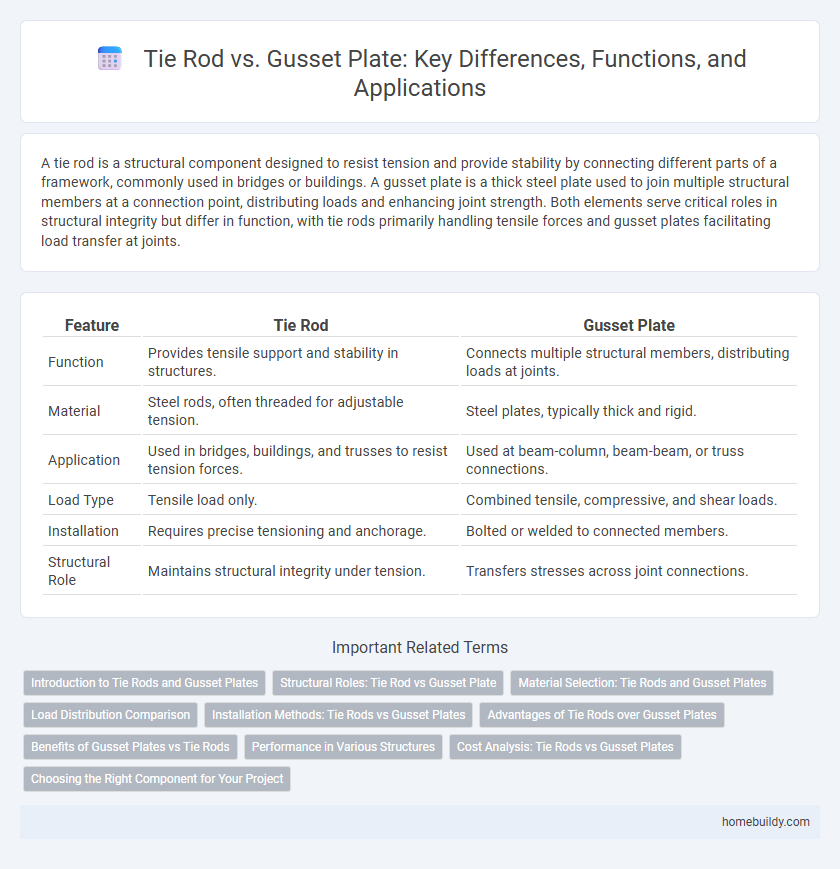A tie rod is a structural component designed to resist tension and provide stability by connecting different parts of a framework, commonly used in bridges or buildings. A gusset plate is a thick steel plate used to join multiple structural members at a connection point, distributing loads and enhancing joint strength. Both elements serve critical roles in structural integrity but differ in function, with tie rods primarily handling tensile forces and gusset plates facilitating load transfer at joints.
Table of Comparison
| Feature | Tie Rod | Gusset Plate |
|---|---|---|
| Function | Provides tensile support and stability in structures. | Connects multiple structural members, distributing loads at joints. |
| Material | Steel rods, often threaded for adjustable tension. | Steel plates, typically thick and rigid. |
| Application | Used in bridges, buildings, and trusses to resist tension forces. | Used at beam-column, beam-beam, or truss connections. |
| Load Type | Tensile load only. | Combined tensile, compressive, and shear loads. |
| Installation | Requires precise tensioning and anchorage. | Bolted or welded to connected members. |
| Structural Role | Maintains structural integrity under tension. | Transfers stresses across joint connections. |
Introduction to Tie Rods and Gusset Plates
Tie rods are slender structural components designed to resist tension, commonly used in trusses and frameworks to provide lateral stability. Gusset plates are flat steel connectors that join multiple structural members at a node, distributing loads and reinforcing joint integrity. Both tie rods and gusset plates are essential in ensuring strength and rigidity in construction, with tie rods primarily handling tensile forces and gusset plates facilitating load transfer and connection stability.
Structural Roles: Tie Rod vs Gusset Plate
Tie rods primarily function as tension members, providing structural stability by resisting tensile forces and preventing lateral movement in frameworks. Gusset plates serve as critical connection points, distributing loads between tie rods, beams, and columns, ensuring joint rigidity and overall structural integrity. While tie rods maintain tension, gusset plates enable effective load transfer and secure connections within truss systems and steel frameworks.
Material Selection: Tie Rods and Gusset Plates
Tie rods are typically fabricated from high-strength steel alloys such as carbon steel or alloy steel to provide tensile strength and durability under tension. Gusset plates are often made from structural steel, including ASTM A36 or A572 grades, chosen for their excellent weldability and resistance to shear and compressive forces. Material selection for both components is critical to ensure compatibility in mechanical properties and corrosion resistance within structural applications.
Load Distribution Comparison
Tie rods provide direct tensile load transfer, efficiently carrying axial forces along their length with minimal bending stress. Gusset plates distribute loads across a broader surface area, connecting multiple structural members to reduce localized stress concentrations. The choice between tie rods and gusset plates depends on the specific load path and structural requirements for optimal load distribution.
Installation Methods: Tie Rods vs Gusset Plates
Tie rod installation typically involves threaded ends secured with nuts, allowing precise tension adjustments and straightforward alignment during assembly. Gusset plates require welding or bolting to connect multiple structural members, demanding careful positioning and preparation to ensure adequate load transfer and structural integrity. The installation process for tie rods is generally faster and less labor-intensive compared to the more involved and permanent setup of gusset plates.
Advantages of Tie Rods over Gusset Plates
Tie rods offer superior tensile strength and flexibility compared to gusset plates, making them ideal for dynamic load applications in construction. Their streamlined design reduces material usage and weight, enhancing structural efficiency and ease of installation. Tie rods also provide adjustable tensioning capabilities, allowing for precise alignment and improved stability in various frameworks.
Benefits of Gusset Plates vs Tie Rods
Gusset plates offer enhanced load distribution by connecting multiple structural members at a single joint, reducing stress concentrations compared to tie rods that carry tensile forces along a single axis. The rigidity of gusset plates improves overall structural stability and resists lateral forces more effectively than flexible tie rods. Installation of gusset plates is often simpler in complex frameworks, providing increased durability and maintenance advantages over tie rods in heavy load applications.
Performance in Various Structures
Tie rods exhibit superior tensile strength and flexibility, making them ideal for dynamic load-bearing applications in bridges and steel frameworks. Gusset plates provide enhanced stability and connection rigidity, particularly effective in trusses and complex joint assemblies. Performance differences depend on structural demands, with tie rods favored for tension distribution and gusset plates excelling in shear resistance and load transfer.
Cost Analysis: Tie Rods vs Gusset Plates
Tie rods generally offer a more cost-effective solution compared to gusset plates, as they require less material and simpler fabrication processes, reducing overall expenses. Gusset plates often entail higher labor and welding costs due to their complex installation and the need for precise alignment with multiple structural members. When evaluating structural reinforcement options, tie rods provide budget-friendly strength and flexibility, while gusset plates demand higher initial investment but may enhance joint stability in specific engineering applications.
Choosing the Right Component for Your Project
Selecting between a tie rod and a gusset plate depends on the structural requirements and load distribution of your project. Tie rods provide tension support and are ideal for spanning long distances with minimal weight, while gusset plates are better suited for reinforcing joints by distributing stress at connection points. Evaluating factors such as load type, material compatibility, and installation complexity ensures the optimal choice for stability and durability.
tie rod vs gusset plate Infographic

 homebuildy.com
homebuildy.com